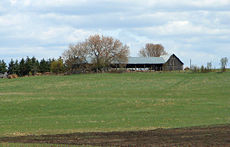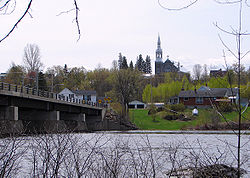
L'Isle-aux-Allumettes, Quebec
Encyclopedia
L'Isle-aux-Allumettes is a municipality in the Outaouais region, part of the Pontiac Regional County Municipality, Quebec
, Canada. The municipality consists primarily of Allumette Island (in French Île aux Allumettes), and also includes Morrison Island, Marcotte Island, and some minor islets, all in the Ottawa River
north of Pembroke, Ontario
.
In the past, the island and municipalities have been spelled in French in various ways:
The municipality consists mostly of agricultural land. Its population centres are Chapeau
, Desjardinsville, Demers Centre, and Saint-Joseph.
named it Isle des Algoumequins during his trip of 1613. In 1650, this native population was almost entirely exterminated by the Iroquois
.
In his memoirs written during the second half of the 17th century, Nicolas Perrot made mention of the "One-Eyed Island otherwise called Allumette Island" ("Isle du Borgne autrement ditte l'Isle des Allumettes"). The name "One-Eyed" was a reference to the disability of Tessouat
, an Algonquin chief in the region. The name "Allumettes" (literally meaning "match
es") was fist given to the rapids south-east of the island. A map from 1680 refers to these as Sault
des Allumettes (Allumette Falls).
It was not until 1818 that Europeans began to settle on the island. They worked mostly as loggers or for the Hudson's Bay Company
which had a fur trading post just upstream at Fort William
. The preferred transport route was still the river, so most families build their homes south on the island where the church of Saint-Alphonse-de-l'Île-aux-Allumettes Parish was built in 1840. The Île-aux-Allumettes Township was formed in 1847, and its first mayor was Andrew Whelan.
 An intense fire destroyed almost all the buildings in 1853 and, thereafter, the population rather settled in the northern part, on the current site of Chapeau village
An intense fire destroyed almost all the buildings in 1853 and, thereafter, the population rather settled in the northern part, on the current site of Chapeau village
. In 1874, the village of Chapeau separated from the township and became an incorporated municipality, with Patrick Cunningham as the first mayor.
In 1910, the parish of Saint-Joseph-de-l'Île-aux-Allumettes was established on the eastern part of the island, leading to the formation of the Municipality of L'Isle-aux-Allumettes-Partie-Est in 1920.
On December 30, 1998, the municipality of Chapeau Village and the township municipalities of L'Isle-aux-Allumettes and L'Isle-aux-Allumettes-Part-East were regrouped into the new Municipality of L'Isle-aux-Allumettes.
, a farmer by the name of Leo-Paul Chaput was awakened at 2 am, and witnessed a brilliant white light emanating from a flat-bottomed domed craft, resembling a French WWI military helmet
. The next morning, a 32 feet (9.8 m) wide circular imprint was found in the ground, with a ring of scorched grass 2.5 foot (0.762 m) wide, containing three indentations forming an equilateral triangle, with sides 15 feet (4.6 m) long, each dent 8 inches (20.3 cm) wide and 3 inches (7.6 cm) deep, suggesting a "landing tripod". A second smaller circle was also found, with a ring of scorched grass, but the triangle of indentations was smaller and not equilateral. A third scorched marking, although a semicircle, contained a pile of rocks. An explanation was offered that the circles were fairy ring
s, but this seems unlikely as they take years to achieve such a size and the witness insisted the markings were not there the day before.
 Population:
Population:
Total private dwellings (excluding seasonal cottages): 574
Mother tongues:
Pontiac Regional County Municipality, Quebec
Pontiac is a county regional municipality MRC Pontiac in the Outaouais region of Quebec, Canada. It should not be confused with the municipality of Pontiac, which is located inside the county regional municipality of Les Collines-de-l'Outaouais....
, Canada. The municipality consists primarily of Allumette Island (in French Île aux Allumettes), and also includes Morrison Island, Marcotte Island, and some minor islets, all in the Ottawa River
Ottawa River
The Ottawa River is a river in the Canadian provinces of Ontario and Quebec. For most of its length, it now defines the border between these two provinces.-Geography:...
north of Pembroke, Ontario
Pembroke, Ontario
Pembroke is a city in the province of Ontario, Canada, at the confluence of the Muskrat River and the Ottawa River in the Ottawa Valley...
.
In the past, the island and municipalities have been spelled in French in various ways:
- Isle-des-Allumettes
- L'Île-Allumettes
- Île-aux-Allumettes
Geography
Allumette Island is 22 kilometres (13.7 mi) long and 12 kilometres (7.5 mi) wide, making it the largest island within the Ottawa River along its entire course. At this point the Ottawa River has widened into a lake, called Allumette Lake, which is 52 km (32.3 mi) long and has a total surface area of 120 km² (46.3 sq mi).The municipality consists mostly of agricultural land. Its population centres are Chapeau
Chapeau, Quebec
Chapeau is a village in the Canadian province of Quebec, located along the Culbute Channel of the Ottawa River in the municipality of L'Isle-aux-Allumettes in Pontiac Regional County Municipality....
, Desjardinsville, Demers Centre, and Saint-Joseph.
History
The Algonquins first occupied the site in order to maintain control of trade on the Ottawa River. For this reason, Samuel de ChamplainSamuel de Champlain
Samuel de Champlain , "The Father of New France", was a French navigator, cartographer, draughtsman, soldier, explorer, geographer, ethnologist, diplomat, and chronicler. He founded New France and Quebec City on July 3, 1608....
named it Isle des Algoumequins during his trip of 1613. In 1650, this native population was almost entirely exterminated by the Iroquois
Iroquois
The Iroquois , also known as the Haudenosaunee or the "People of the Longhouse", are an association of several tribes of indigenous people of North America...
.
In his memoirs written during the second half of the 17th century, Nicolas Perrot made mention of the "One-Eyed Island otherwise called Allumette Island" ("Isle du Borgne autrement ditte l'Isle des Allumettes"). The name "One-Eyed" was a reference to the disability of Tessouat
Tessouat
Tessouat was an Algonquin chief from the Kitchesipirini nation . His nation lived in an area extending from Lac des Deux-Montagnes to Pembroke, Ontario.Tessouat lived in L'Isle-aux-Allumettes, in a neck of the Ottawa River...
, an Algonquin chief in the region. The name "Allumettes" (literally meaning "match
Match
A match is a tool for starting a fire under controlled conditions. A typical modern match is made of a small wooden stick or stiff paper. One end is coated with a material that can be ignited by frictional heat generated by striking the match against a suitable surface...
es") was fist given to the rapids south-east of the island. A map from 1680 refers to these as Sault
Sault
Sault is a commune in the Vaucluse department in the Provence-Alpes-Côte d'Azur region in southeastern France.-References:*...
des Allumettes (Allumette Falls).
It was not until 1818 that Europeans began to settle on the island. They worked mostly as loggers or for the Hudson's Bay Company
Hudson's Bay Company
The Hudson's Bay Company , abbreviated HBC, or "The Bay" is the oldest commercial corporation in North America and one of the oldest in the world. A fur trading business for much of its existence, today Hudson's Bay Company owns and operates retail stores throughout Canada...
which had a fur trading post just upstream at Fort William
Sheenboro, Quebec
Sheenboro is a village and municipality in the Outaouais region, part of the Pontiac Regional County Municipality, Quebec, Canada. Its territory stretches along the north shore of the Ottawa River from Chichester to Rapides-des-Joachims....
. The preferred transport route was still the river, so most families build their homes south on the island where the church of Saint-Alphonse-de-l'Île-aux-Allumettes Parish was built in 1840. The Île-aux-Allumettes Township was formed in 1847, and its first mayor was Andrew Whelan.

Chapeau, Quebec
Chapeau is a village in the Canadian province of Quebec, located along the Culbute Channel of the Ottawa River in the municipality of L'Isle-aux-Allumettes in Pontiac Regional County Municipality....
. In 1874, the village of Chapeau separated from the township and became an incorporated municipality, with Patrick Cunningham as the first mayor.
In 1910, the parish of Saint-Joseph-de-l'Île-aux-Allumettes was established on the eastern part of the island, leading to the formation of the Municipality of L'Isle-aux-Allumettes-Partie-Est in 1920.
On December 30, 1998, the municipality of Chapeau Village and the township municipalities of L'Isle-aux-Allumettes and L'Isle-aux-Allumettes-Part-East were regrouped into the new Municipality of L'Isle-aux-Allumettes.
UFO Landing Incident
On May 11, 1969, near ChapeauChapeau, Quebec
Chapeau is a village in the Canadian province of Quebec, located along the Culbute Channel of the Ottawa River in the municipality of L'Isle-aux-Allumettes in Pontiac Regional County Municipality....
, a farmer by the name of Leo-Paul Chaput was awakened at 2 am, and witnessed a brilliant white light emanating from a flat-bottomed domed craft, resembling a French WWI military helmet
Adrian helmet
The M15 Adrian helmet was a combat helmet issued to the French Army during World War I. It was the first standard helmet of the French Army and was designed when millions of French troops were engaged in trench warfare, and head wounds became a frequent cause of battlefield casualties...
. The next morning, a 32 feet (9.8 m) wide circular imprint was found in the ground, with a ring of scorched grass 2.5 foot (0.762 m) wide, containing three indentations forming an equilateral triangle, with sides 15 feet (4.6 m) long, each dent 8 inches (20.3 cm) wide and 3 inches (7.6 cm) deep, suggesting a "landing tripod". A second smaller circle was also found, with a ring of scorched grass, but the triangle of indentations was smaller and not equilateral. A third scorched marking, although a semicircle, contained a pile of rocks. An explanation was offered that the circles were fairy ring
Fairy ring
A fairy ring, also known as fairy circle, elf circle, elf ring or pixie ring, is a naturally occurring ring or arc of mushrooms. The rings may grow to over in diameter, and they become stable over time as the fungus grows and seeks food underground. They are found mainly in forested areas, but...
s, but this seems unlikely as they take years to achieve such a size and the witness insisted the markings were not there the day before.
Demographics

- Population in 2006: 1443
- Population in 2001: 1385
- 2001 to 2006 population change: 4.2 %
- Population in 1996: 1482
- Population in 1991: 1430
Total private dwellings (excluding seasonal cottages): 574
Mother tongues:
- English as first language: 78 %
- French as first language: 21 %
- Other as first language: <1 %

